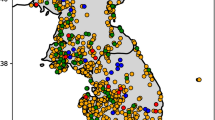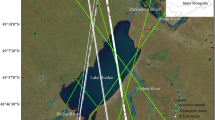Abstract
By using remote sensing and GIS technologies, spatial analysis and statistic analysis, we calculated the water area and volume variations of the Nam Co Lake from 1971–2004, and discussed their influence factors from the viewpoints of climatic change and water balance. Data source in this study includes bathymetric data of the lake, aerial surveyed topographic maps of 1970, remote sensing images of 1991 and 2004 in the lake catchment, meteorological data from 17 stations within 1971–2004 in the adjacent area of the lake catchment. The results showed that the lake area expanded from 1920 km2 to 2015 km2 during 1971 to 2004 with the mean annual increasing rate (MAIR) of 2.81 km2 a−1, and the lake volume augmented from 783.23×108 m3 to 863.77×108 m3 with the MAIR of 2.37×108 m3. Moreover, the MAIR of the lake area and volume are both higher during 1992 to 2004 (4.01 km2 a−1 and 3.61×108 m3 a−1) than those during 1971 to 1991 (2.06 km2 a−1 and 1.60×108 m3 a−1). Analyses of meteorological data indicated that the continue rising of air temperature conduced more glacier melting water. This part of water supply, together with the increasing precipitation and the descending evaporation, contributed to the enlargement of Nam Co Lake. The roughly water balance analyses of lake water volume implied that, in two study periods (1971–1991 and 1992–2004), the precipitation supplies (direct precipitations on the lake area and stream flow derived from precipitations) accounted for 63% and 61.92% of the whole supplies, while the glacier melting water supplies occupied only 8.55% and 11.48%, respectively. This showed that precipitations were main water supplies of the Nam Co Lake. However, for the reason of lake water increasing, the increased amount from precipitations accounted for 46.67% of total increased water supplies, while the increased amount from glacier melting water reached 52.86% of total increased water supplies. The ratio of lake evaporation and lake volume augment showed that 95.71% of total increased water supplies contributed to the augment of lake volume. Therefore, the increased glacier melting water accounted for about 50.6% of augment of the lake volume, which suggested that the increased glacier melting water was the main reason for the quickly enlargement of the Nam Co lake under the continuous temperature rising.
Similar content being viewed by others
References
Wang S M, Dou H S. Records of Lakes in China (in Chinese). Beijing: Science Press, 1998. 398–399
Hartmann H C. Climate change impacts on Lanrentian great lakes levels. Clim Change, 1990, 17: 49–67
Oviatt C G. Lake Bonneville fluctuations and global climate change. Geology, 1997, 25: 155–158
Jones R N, McMahon T A, Bowler J M. Modeling historical lake levels and recent climate change at three closed lakes, Western Victoria, Australia (c.1840–1990). J Hydrol, 2001, 246: 159–180
Yu G, Xue B, Wang S M, et al. Lake records and LGM climate in China. Chinese Sci Bull, 2000, 45:1158–1164
Jiang J H, Huang Q. Distribution and variation of lakes in Tibetan Plateau and their comparison with lakes in other part of China (in Chinese). Water Resour Protect, 2004, 4: 24–27
Zhu L P, Ju J T, Wang J B, et al. Environmental changes recorded in core sediments from the Pumoyum Co Lake of the Tibetan Plateau during the initial stage of the Last Deglacial Period (in Chinese). Quat Sci, 2006, 26: 772–780
Singh P, Bengtsson L. Impact of warmer climate on melt and evaporation for the rainfed, snowfed and glacierfed basins in the Himalayan region. J Hydrol, 2005, 300: 140–154
Harrison S, Glasser N, Winchester V, et al. A glacial lake outburst flood associated with recent mountain glacier retreat, Patagonian Andes. Holocene, 2006, 16: 611–620
IPCC. Climate Change 2007: the AR4 Synthesis Report. 2007
Quincey D J, Richardson S D, Luckman A, et al. Early recognition of glacial lake hazards in the Himalaya using remote sensing datasets. Glob Planet Change, 2007, 56: 137–152
Chu Y H, Li J C, Jiang W P, et al. Monitoring level fluctuations of the lakes in the Yangtze River basin from radar altimetry. Terres Atmos Oceanic Sci, 2008, 19: 63–70
Yang L, Chen F, Chun X, et al. The Jilantai Salt Lake shorelines in northwestern arid China revealed by remote sensing images. J Arid Environ, 2008, 72: 861–866
Yang R H, Yu X Z, Li Y L. The Dynamic Analysis of Remote Sensing Information for Monitoring the Expansion of the Selincuo Lake in Tibet(in Chinese). Remote Sensing Land Resour, 2003, 64–67
Lu A X, Yao T D, Wang L H, et al. Study on the fluctuations of typical glaciers and lakes in the Tibetan Plateau using remote sensing (in Chinese). J Glaciol Geocryol, 2005, 27: 783–792
Bian D, Yang Z G, Li L, et al. The response of lake area change to climate variations in north Tibetan Plateau during last 30 years (in Chinese). Acta Geogr Sin, 2006, 61: 510–518
Li X Y, Xu H Y, Sun Y L. Lake-level change and water balance analysis at Lake Qinghai, West China during recent decades. Water Resour Manage, 2007, 21: 1505–1516
Ye Q H, Zhu L P, Zheng H X, et al. Glacier and lake variations in the Yamzhog Yumco basin, southern Tibetan Plateau, from 1980 to 2000 using remote-sensing and GIS technologies. J Glaciol, 2007, 53: 673–676
Wu Y H, Zhu L P. The response of lake-glacier variations to climate change in Nam Co Catchment, central Tibetan Plateau during 1970–2000. J Geogr Sci, 2008, 18: 177–189
Guan Z H, Chen C Y, Ou Y X, et al. Rivers and Lakes in Tibet (in Chinese). Beijing: Science Press, 1984. 176–182
Zhu D G, Zhao X T, Meng X G, et al. Late Pleistocene Lacustrine-beach Rock around the Nam Co in Xizang (in Chinese). Geol Rev, 2003, 49: 432–438
Zhu D G, Meng X G, Zhao X T, et al. Lake-level change of Nam Co, Tibet, since the Late Pleistocene and environment information of clay minerals in lacustrine deposits (in Chinese). J Geomech, 2004, 10: 300–309
Zhu L P, Wu Y H, Wang J B, et al. Environmental changes reflected from the core sediments since 8.4 ka in Nam Co, central Tibet of China. Holocene, 2008, 18: 831–839
Xie M P, Zhu L P, Peng P, et al. Ostracod Assemblages and Their Environmental Significance from the Lake Core of the Nam Co on the Tibetan Plateau since 8400 years Ago. J Geogr Sci, 2009, 19: 387–402
Wu Z H, Zhao X T, Wu Z H, et al. Palaeovegetation, Palaeoclimate and Lake-level Chang since 120 ka BP in Nam Co, Central Xizang (in Chinese). Acta Geol Sin, 2004, 78: 242–252
Zhu L P, Xie M P, Peng P, et al. Ostracod assemblages and their implications on environmental reconstruction in the Nam Co of the Tibetan Plateau. Hydrobiologia, 2009, 62, doi: 10.1007/s10750-010-0149-3
Lu A X, Wang L H, Yao T D. The study of Yamzho Lake and Chencuo Lake variation using remote sensing in Tibet Plateau from 1970 to 2000 (in Chinese). Remote Sens Technol Appl, 2006, 21: 173–177
Ye Q H, Kang S C, Chen F, et al. Monitoring glacier variations on Geladandong mountain, central Tibetan Plateau, from 1969 to 2002 using remote-sensing and GIS technologies. J Glaciol, 2006, 52: 537–545
Yang Z N, Hu M G. Streamflow characteristics of the eastern Qinghai Plateau (in Chinese). J Glaciol Geocryol, 1990, 12: 219–226
Hutchinson M F. Interpolation of rainfall data with thin plate moothing splines—Part I. Two-dimensional smoothing of data with short range correlation. J Geogr Inf Decision Anal, 1998, 2: 139–151
Hutchinson M F, Hogarth W, Rose C W. Interpolation of rainfall data with thin plate smoothing splines—Part II. Two-dimensional smoothing of data with short range correlation. J Geogr Inf Decision Anal, 1998, 2: 152–167
Zhang G W, Zhou L C. Evaporation properties and estimates in the landlocked arid region in Xinjiang, China (in Chinese). Adv Water Sci, 1992, 3: 226–232
Zhang Y S, Pu J C, Tai Tian Y S. Analysis of characteristics of evaporation in centre of Tibetan Plateau (in Chinese). J Glaciol Geocryol, 1994, 16: 166–172
Jin X C, et al. Chinese Lake Environment (3rd volume) (in Chinese), Beijing: Ocean Press, 1995. 80–90
Li W C, Li S J, Pu P M. Estimates of plateau lake evaporation: A case study of Zige Tangco (in Chinese). J Lake Sci, 2001, 13: 227–232
Wu Y H,. The variations of glaciers and lakes and their response to climatic changes in the Nam Co Basin of Tibet. Dissertation for the Doctoral Degree. Beijing: Institute of Geographical Sciences and Natural Resources Research, Chinese Academy of Sciences, 2008
Allen R G, Pereira L S, Raes D, et al. Crop evapotranspiration guidelines for computing crop water requirements. FAO irrigation and drainage paper 56.1998.http://www.fao.org/docrep/X0490E/x0490e00.htm.
Terpstra J, van Mazijk A. Computer aided evaluation of planning scenarios to assess the impact of land-use changes on water balance. Phys Chem Earth, Part B: Hydrol Oceans Atmos, 2001, 26: 523–527.
Shi Y F. Concise Glacier Inventory of China (in Chinese). Shanghai: Shanghai Science Popularization Press, 2005. 1–30
Wang J B, Zhu L P, Daut G, et al. Investigation of bathymetry and water quality of Lake Nam Co, the largest lake on the central Tibetan Plateau, China. Limnology, 2009, 10: 149–158
Shi Y F, Shen Y P, Li D L, et al. Discussion on the present climate change from warm-dry to warm-wet in Northwest China (in Chinese). Quat Sci, 2003, 23: 152–164
Zhou L S, Wang Q C. Analysis and forecast for inter-annual variation of the Qinghai Lake’s water level (in Chinese). Plateau Meteorol, 1996, 15: 478–484
Li L, Zhu X D, Wang Z Y, et al. Impacting factors and changing tendency of water level in Qinghai Lake in recent 42 years (in Chinese). J Desert Res, 2005, 25: 689–696
Liu T C. Changes of Yamzhoy Yum Lake water stage in Xizang (in Chinese). Sci Geogr Sin, 1995, 15: 91–98
Zhao Y Y, Zhao X T, Zheng M P, et al. the Denivellation of Bankog Co in the past 50 years, Tibet (in Chinese). Acta Geol Sin, 2006, 80: 876–884
Zhang J C, Jiang Q G, Li Y H, et al. Dynamic monitoring and climatic background of lake changes in Tibet based on RS/GIS (in Chinese). J Earth Sci Environ, 2008, 30: 87–93
Ding Y J. Response of cryosphere to climatic warming since 1980 over the Northern Hemisphere (in Chinese). J Glaciol Geocryol, 1996, 18: 131–138
Su Z, Liu Z X, Wang W T, et al. Glacier fluctuations responding to climate change and forecast of its tendency over the Qinghai-Tibet Plateau(in Chinese). Adv Earth Sci, 1999, 14: 607–612
Gao X Q, Tang M C, Feng S. Discussion on the relationship between glacial fluctuation and climate change(in Chinese). Plateau Meteorol, 2000, 19: 10–19
Dyurgerov M B, Meier M F. Twentieth century climate change: Evidence from small glaciers. In: Proceedings of the National Academy of Sciences of the United States of America, 2000, 97: 1406–1411
Lin Z Y, Zhao X Y. Spatial characteristics of changes in temperature and precipitation of the Qinghai-Xizang (Tibet) Plateau. Sci China Ser D-Earth Sci, 1996, 39: 442–448
Li L, Zhu X D, Qin N S. Study on temperature variations and its anomaly pattern over Qinghai-Xizang Plateau (in Chinese). Plateau Meteorol, 2003, 22: 524–530
Zhang T T, Ren J W, Kang S C. Lanong Glacier retreat in Nyaiqentaglha range of Tibetan Plateau during 1970–2003 (in Chinese). J Glaciol Geocryol, 2004, 26: 736–739
Author information
Authors and Affiliations
Corresponding author
Additional information
These authors contributed equally to this work
About this article
Cite this article
Zhu, L., Xie, M. & Wu, Y. Quantitative analysis of lake area variations and the influence factors from 1971 to 2004 in the Nam Co basin of the Tibetan Plateau. Chin. Sci. Bull. 55, 1294–1303 (2010). https://doi.org/10.1007/s11434-010-0015-8
Received:
Accepted:
Published:
Issue Date:
DOI: https://doi.org/10.1007/s11434-010-0015-8




